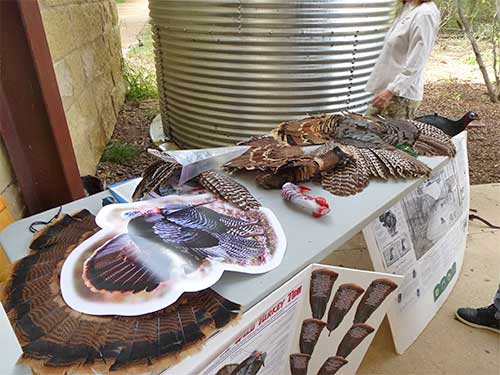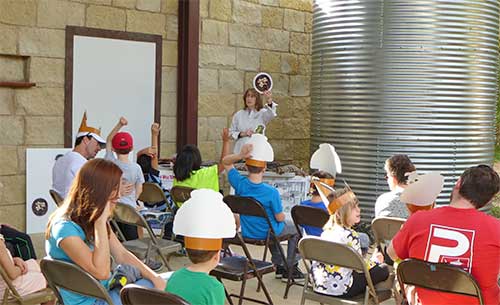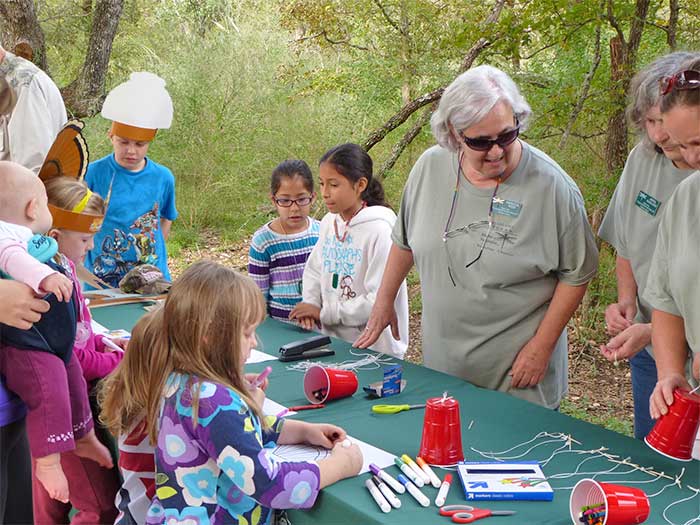Wild Turkey Federation
On Nov. 16, 2013, members of the Alamo Chapter Wild Turkey Federation presented Wild Turkeys in Texas at Phil Hardberger Park. The Alamo Area Master Naturalists sponsored the program. Here are highlights of the presentation.
Wild Turkey Presentation Highlights at TWPD’s sponsored event at Phil Hardberger Park on November 16, 2013 – by Alamo Chapter NWTF.
The turkey you eat at Thanksgiving is probably NOT anything like the beautiful wild turkey we have in Texas and throughout the North American continent. “Mr. Butterball” is generally all white, fat, doesn’t fly and is not known to be very smart. The wild turkey, however, is very dark (with the male being an iridescent black and the female a dark shade of brown); it can fly 55 mph and it can run with speeds up to 25 mph. (Hint: domestic turkey legs are much tastier, but wild turkey breast meat can be most enjoyable.)
Once found in great numbers throughout North America, the wild turkey became nearly extinct in the late 1800’s through early 1900’s. A concerted effort was made to reverse this trend through legislative action changing the laws so that turkeys could be hunted only during specific seasons and with restricted numbers. In 1973, the National Wild Turkey Federation (NWTF) was formed to continue the efforts of conserving this noble bird. From only 30,000 turkeys in the early 1900’s to more than 7 million today, this intriguing species has truly made an awesome comeback.

Be thankful for the wild turkey because it gave your tasty Thanksgiving domestic turkey its beginning. Interestingly, when the wild turkey numbers were so low, attempts were made to take wild turkey eggs, put them with “tame” turkeys, and release the newly hatched birds into the wild. None survived. The poults needed their wild turkey mama hen to imprint them with knowledge on how to survive in the wild. Through NWTF efforts, net-capturing and transplanting the turkeys into other areas successfully increased the numbers.
The wild turkey has five subspecies within North America. The majority in Texas is the Rio Grande Turkey, and those in the eastern part of Texas are known as the Eastern subspecies. The other subspecies include the Merriam’s, Gould’s and Osceola. The wild turkey is now found in all 49 states, except Alaska. The Oscellated turkey is a sixth subspecies. Unique to the Yucatan Peninsula, it looks totally different and seems to have more peacock-like features.
The adult female (hen) lays 10 to 14 eggs, about one a day. It then sits on the eggs for about a month until the eggs hatch all at one time. Of course, it seems like everything enjoys eating these eggs—coyotes, raccoons, armadillos, snakes, bobcats, skunks, crows—and as a result only about half of the eggs make it to hatching. Once hatched, life hardly gets any easier since now hawks, eagles, and foxes all want a piece of that cute poult. Thank goodness these little ones can fly within 8 to 10 days and get into trees to escape from predators. Before you know it, the whole flock is enjoying a good night’s sleep high in the trees.
When the young poults get a bit older (if they were humans, it would be their teen years), the male is called a jake and the female is called a jenny. The jakes tend to get in gangs and try to impress the females by strutting around with their bright red heads. Only, the jakes’ tail feathers give them away, because they are not fully developed-- only the center feathers are long, while the side feathers are shorter, making a notched appearance. The male also grows a beard and spurs, both of which are much shorter on the young jake. When the male gets older, around 2 ½ years old or more, he is referred to as a tom and has a full, even-length tail, longer spurs and a beard of about 9” or longer. The tom’s head can be white, blue and red—a most patriotic bird! Both the jake and the tom are referred to as gobblers, because they make a gobble sound to attract the female. The female is smaller in size and her plumage is dark brown with just a small amount of red on her neck and the back of her head is thinly feathered. She, too, can have a beard, but this is not very common.

These birds enjoy eating things like insects, acorns, berries, and because they also like corn, it is used as bait in many hunting areas in Texas. In the natural order of things, during mating season in the spring, the gobblers strut around and gobble a lot, basically telling the females, “Here I am; don’t I look great; come over here.” In order to outsmart them during hunting season, the hunter attempts to sound like a very enticing female, making noises called yelps and purrs and hopefully is saying, “Here I am, sweetie. You better come over here to me, instead.” The hunter cannot move around and try to get close to a turkey, because it has VERY good eyesight and will run away. In fact, turkeys can see almost all the way around, about 270 degrees. They are aware of every movement (another reason hunters wear full camo and stay very still). Turkeys can also hear very well, but do not have a good sense of smell—thank goodness, or they just might outsmart us hunters every time!
Learn more about how to get involved in conserving our Hunting Heritage and keeping our native wild turkey around for future generations by visiting www.nwtf.org. For youth, ages 9 to 17, go online to Texas Youth Hunting Program and find out how you can participate in a future turkey hunt.

